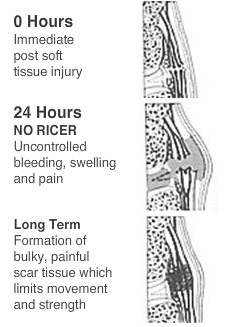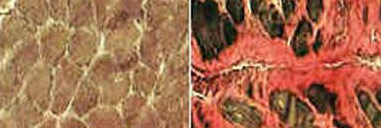Scar Tissue the Culprit
Muscle Scar Tissue
Left – is normal muscle tissue Right – is scar tissue in muscle
A perfectly healthy muscle can be stretched beyond its normal range, resulting in a tear. This can often be the starting point for chronic muscle pain and associated dysfunction. Adhesion Recovery and Release Program breaks down the adhesions in the scar tissue and adjacent muscles or tendons, and re-aligns the muscle fibers.
Healing Process
Scar Tissue occurs as a result of injury , surgery, or repetitive motion. When a muscle, tendon, or ligament is torn (strained or sprained), healing occurs in three phases called: acute inflammation, repair, and remodeling. In acute inflammation (phase 1), swelling, bleeding, and pain occur. This phase lasts approximately 72 hours. After the inflammation recedes, repair (phase 2) begins. The damaged tissues heal with adhesions or scar tissue formation rather than the formation of brand new tissue. In phase 3, remodeling occurs as the body redirects the healing fibers attempting to increase strength and lay the tissue fibers along the lines of greatest stress. The largest of the 3 phases, this process can continue for years.
In addition, when a muscle tightens up– through a repetitive motion such as typing, or after it has been injured– swelling occurs, and it restricts the oxygen supply to the muscles and connective tissues (hypoxia). The lack of oxygen also causes scar tissue to form.
The Problem with Scar Tissue
This scar tissue can adhere to muscle, ligament, tendon, and fibers preventing them from sliding back and forth properly, thus limiting the flexibility of a muscle or joint. Over time, this restriction of motion in the spine and extremities (e.g. shoulders, knees, and hips) leads to disc and joint degeneration. Research has proven scar tissue to be weaker, less elastic, more prone to future re-injury and many times more pain sensitive than normal, healthy tissue. Chronic pain is the result, pain that could remain for years after the initial injury.
Long-Term Effects
While the body’s formation of scar tissue is an incredible demonstration of the body’s healing ability, the resulting fibrous adhesions can set the stage for problems down the road. Untreated scar tissue is a major cause of re-injury, usually months after you thought that the injury had fully healed. Composed primarily of collagen, scar tissue’s fibrosity prohibits adequate circulation. In addition to the physical limitations of scar tissue, the lack of blood flow and lymph drainage occurring in scar tissue makes it vulnerable to dysfunction. Lastly, the formation of scar tissue will result in a loss of strength and power. For a muscle to attain full power it must be fully stretched before contraction. Both the shortening effect and weakening of the tissues means that a full stretch and optimum contraction is not possible. The resulting abnormal stress on a scar’s surrounding structures may include:
- Nerve impingement
- Pain
- Numbness
- Limited range of motion and flexibility
- Postural misalignment
- Muscle atrophy
- Tissue hypoxia – (lack of oxygen)
- An increase in potential for future injury



